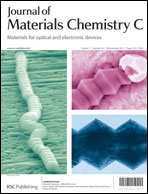Blue light emitting electrochemical cells incorporating triazole-based luminophores†
Abstract
We report the electrochemical, photoluminescence, and electroluminescence properties of four fluorinated cationic iridium complexes bearing pyridyltriazole ancillary ligands. All the complexes display unstructured emission in the true blue region at 298 K with photoluminescent λem ranging from 452 to 487 nm in acetonitrile solution, in powder and in PMMA doped thin films. The nature of the emission is a mixed metal-to-ligand/ligand-to-ligand charge transfer state. Photoluminescence (PL) quantum efficiencies both in solution and in the solid state were low while excited state decay kinetics were found to be multiexponential. Each complex undergoes quasi-reversible oxidation and irreversible reduction with large HOMO–LUMO gaps. A detailed computational investigation corroborates the spectroscopic assignments. Additionally, light-emitting electrochemical cells (LEECs) were fabricated for each of the four complexes. The electroluminescence (EL) spectra of all complexes were red-shifted relative to the PL spectra. The LEEC containing 2a is the bluest emitter (λmax = 487 nm) of the family of complexes.


 Please wait while we load your content...
Please wait while we load your content...